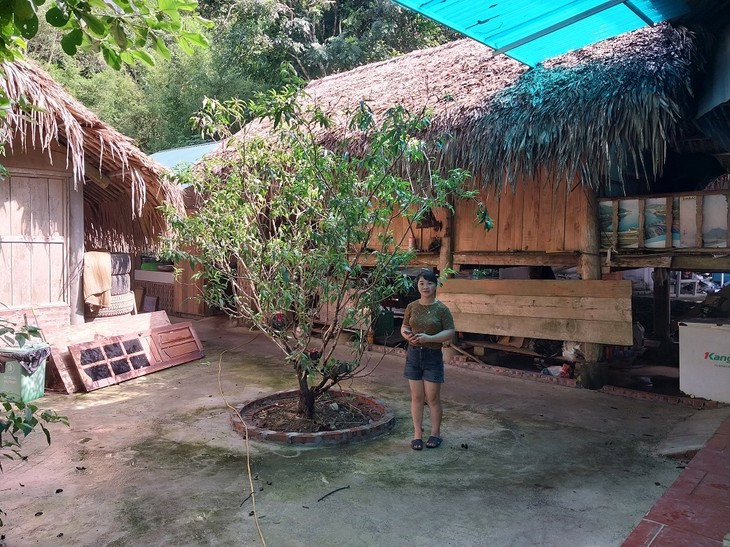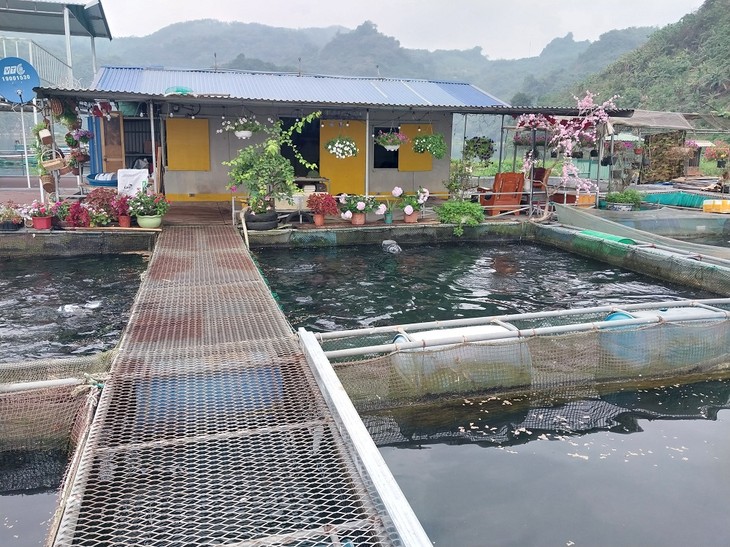(VOVWORLD) -With beautiful scenery and rich flora and fauna ecosystems, Hoa Binh, a mountain province in the northwest, has many advantages for tourism development. It is home to ethnic groups of Muong, Thai, Tay, Dao, and Mong whose cultural identity is unique. Thanks to these advantages, after three years of implementing a project on service and tourism development until 2025, Hoa Binh’s tourism industry has grown toward professionalism and modernity.
 The homestay of Luong Thi Thao in Ke hamlet, Hien Luong commune (Photo: VOV) The homestay of Luong Thi Thao in Ke hamlet, Hien Luong commune (Photo: VOV)
|
For more than a decade, Dinh Nhu Hue of Ke hamlet in Hien Luong commune, Da Bac district, has made the most of local advantages to offer homestay services. Receiving preferential loans from the State, Hue’s family has renovated and repaired their house and built more accommodations for tourists.
He recalled, “Thanks to the State’s support, we now can welcome guests on weekends. We earn between 1,200 and 1,600 USD per month. Our income has been much higher since we started doing community tourism.”
Many households in Ke hamlet have followed Hue's model. Luong Thi Thao, a Ke villager, told VOV, “When I got involved in the tourism business, I was supported with a loan of 4,000 USD and training from Action on Poverty, a community tourism development project of an Australian NGO. They taught me how to prepare my house for guests, cook for the guests, and develop tourism services.”
Hoa Binh has set up more than a dozen new community tourism hamlets of Muong and Mong ethnic people in Da Bac, Mai Chau, and Tan Lac district. Forest protection and development have become more disciplined, rapidly regenerating forest areas.
Acoridng to Dinh Van Quoc, Vice President of the Fatherland Front of Hien Luong commune, since they begin offering tourism services, people's lives have changed and their environmental awareness has increased.
“Hien Luong commune has achieved the new-style rural goals and is working on an advanced new-style rural village. All the villagers are serious about the task. Village roads are kept clean. Garbage is collected. The locals are well aware of environmental protection,” said Quoc.
 Cage fish farming has been combined with tourism at the Hoa Binh hydroelectric reservoir. (Photo: VOV) Cage fish farming has been combined with tourism at the Hoa Binh hydroelectric reservoir. (Photo: VOV)
|
The Hoa Binh Lake National Tourism Area was approved by the Prime Minister in 2016, along with an orientation for tourism development of the Northern midland and mountain region. In addition to developing eco-tourism, community tourism, sports tourism, and spiritual culture, in recent years Hoa Binh has developed aquaculture in line with protecting the lake and its surrounding landscape.
Luong Thanh Hai, Director of the provincial Department of Fisheries, said, “The provincial People's Committee has tasked the Department of Agriculture and Rural Development and its branches with undertaking a project combining cage fish farming of black carp, white carp, and native fish with experiential tourism. Visitors will observe the fish farming operation and sample dishes made from the fish raised in the lake.”
Hoa Binh is also focused on improving its transportation infrastructure, calling on big investors, and developing its tourism in a sustainable way.
Bui Xuan Truong, Deputy Director of the provincial Department of Culture, Sports and Tourism, said that the locality will focus on eco-tourism, community tourism, culture, and sports. “We’ll also expand the traditional sports of our ethnic minorities, organize international cycling and golf tournaments, and develop paragliding to make Hoa Binh's tourism sector competitive with other provinces,” said Truong.
In the first half of this year, Hoa Binh received 2.6 million tourists, up 9.9% from last year, 260,000 of them were foreigners. Hoa Binh plans to attract 4.9 million visitors by 2025. By 2030, its infrastructure will be completed to handle 7.3 million visitors and turn tourism into a spearhead economic sector.